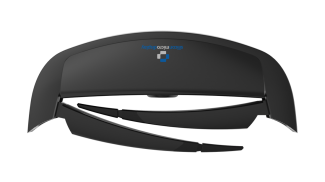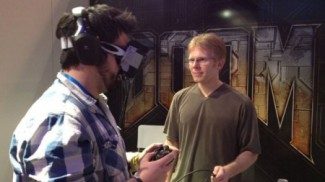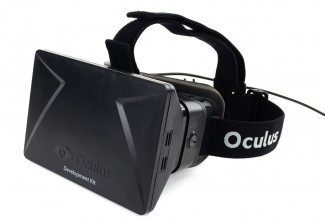

Right Place, Right Time


The time feels right now to start tracking the journey to virtual reality as a number of important technologies are being developed and starting to hit the main stream. These technologies, that are being deployed or are in development, are all stepping stones toward virtual reality. Eventually I see these technologies coalescing into what will be known as virtual reality. A few of these technologies are as follows: motion gaming (Wii/Wii Plus, Xbox Kinect, Playstation Move, etc.), voice control (Apple’s Siri, Android Voice Actions, etc.), and AR gaming (augmented reality) which is found on sensor-rich devices like smartphones and tablets.


It was to be a further 8 months before the gaming public would get their first glimpse at the dawn of a new era of immersive technology. John Carmack, co-founder and programmer at id Software, had taken an interest in a project Palmer Luckey had been discussing at the MTBS3D forum (where he was better known at the time by his alias ‘PalmerTech’). Luckey sent Carmack his only prototype and Carmack began tinkering.
At E3 2012 Carmack, who a decade earlier played a key role in the birth of 3D gaming, was demonstrating what some were dubbing his ‘Magic Hat’—actually a set of ski goggles that apparently put you inside the game. It stole the show, and despite being labelled by some as a “publicity stunt” to promote id Software’s forthcoming Doom 3 BFG (2012), this early showing was so potent that it had gamers, journalists, and developers chattering furiously about its potential. In a surprising turn of events, John Carmack would later become Oculus’ CTO.


Some 10 months after Road to VR launched, Luckey had formed Oculus LLC and teamed up Brendan Iribe, Nate Mitchell, and others, and launched a Kickstarter campaign to fund production of their first VR headset, the Rift development kit 1 (DK1). The device was intended to represent broadly what developers could expect from a finished, commercial headset. The hope was to get these devices out into the wild and spark the imagination of developers who’d begin grappling with the challenges virtual reality application and game development presented, along the way proving to the world that not only was VR now a viable platform—it was here right now! The campaign was to end as one of the most successful Kickstarters of all time, pulling in almost $2.5 million in backer funding, well over the original (and somewhat modest) $250,000 goal. Thousands of DK1s were allocated to backers and many more were pre-ordered post Kickstarter.
Two years on, Oculus is now owned by Facebook and virtual reality is poised to transform entertainment as we know it and much more. Sony’s Project Morpheus proves Oculus are by no means the only player in the VR space, and Samsung prepares to release Gear VR, their mobile VR headset. With countless other companies, innovations, and investments happening in the space, it seems certain that consumer VR is here to stay.
In the mean time, Road to VR has grown to become the largest independent VR news website worldwide, something we’re very proud of. So, to mark our third year, we thought it might be fun to look back and share our favourite moments from the journey thus far.
Ben Lang, Founder and Executive Editor
Given where we are today, it’s amazing to look back at the seed that started Road to VR. In 2011, I was a five year veteran of the technology journalism world, mostly focusing on mobile tech before it was cool (no seriously, I used to carry a Sony UX around in my pocket). During those five years, I came to understand that there’s no better way to learn about something than to read and write about it; both engage your brain in a different way that’s important to learning. I had been working for a number of tech websites throughout the years and wanted to start my own side project to gain the same deep understanding I had acquired about the mobile tech industry, but this time about something new.
‘Virtual Reality Blog’ was just one of a few ideas I had listed in the Notes application on my phone. If I recall, some of the others were an astrophotography blog and a Samsung tablet blog. All were topics that interested me, but in the end virtual reality won out because its potential seemed endless and, thanks to my knowledge of the mobile tech world, I had an inkling that its inception was near.
This is probably an opportune time to explain why I labelled this journey Road to VR. It’s for exactly that reason—this is a journey. A journey between ‘no VR’ and ‘perfect VR’—the latter being an experience indistinguishable from reality (a la The Matrix). I wanted to understand where we were along that journey, where we were going, and how long it would take for us to reach the end. It will probably be beyond my lifetime before we reach ‘perfect VR’, but we are plotting the course nonetheless.
So far it’s been an incredible journey. Road to VR went from an exploration of a curiosity to a full time job. During which time I partnered up with Paul James, Road to VR’s editor, who has in no small part contributed to making the site what it is today. It is a rare and precious moment to find someone who shares both your passion and determination.
Over these three years we’ve been to conferences around the world and worked with some awesome contributors: Brian Hart, “Reverend” Kyle Riesenbeck, “Cymatic” Bruce Wooden, and Jon Tustain (and recently some of you have likely spotted Matt Terndrup).
I was so busy live-blogging the event to make sure the word got out to the rest of the VR community that I hardly had time to process what was being said. I later took a moment to take a step back and gather my thoughts on Morpheus.
Paul James, Editor and Site Partner
By the standards of serious enthusiasts, I came to the VR party late. Although I’d been continually fascinated with the technology since the 90’s hype explosion, like many I’d long since dismissed commercially viable virtual reality as a dream never to become reality. As an avid gamer of almost 30 years, I’d kept track of and indulged in stereoscopic 3D in gaming and movies, and continually found it falling short of my hopes and expectations. So, it was with much excitement that I read about John Carmack’s escapades at E3 2012 with his mysterious ‘Magic Hat’ and immediately started trying to find out more. Once Oculus’ Kickstarter began, I could see that this was going to be huge. I’d spent my life evangelising new technologies, from gaming to home cinema—I was ‘that guy’, the one who would bore the pants off of anyone who’d listen on whatever subjects I was currently obsessed with.
News began to pick up fairly quickly, post Kickstarter, but in September of 2012 it was still definitely just a trickle rather than a flood. I realised that RiftVR.com served much the same purpose as another, much more established blog I’d become aware of, Road to VR run by Ben Lang. As it didn’t make much sense to me that both of us were chasing the same stories, I reached out to Ben to suggest joining forces. Ben and I felt this made a lot of sense and we quickly decided to merge RiftVR into Road to VR so that we could pool resources and create the most compelling source for VR news that we could. That was that: the new Road to VR team was born.
Since that time, VR has grown faster than I’d ever imagined was possible. In the last 2 plus years writing about VR, I’ve been privileged to meet some incredible people and try some amazing things. A few of those moments and their associated stories do however stand out, so here are my two favourite story picks from the Road to VR archives.
GamesCom 2013: Palmer Luckey and Nate Mitchell talk Carmack, InfinitEye and HD Prototypes
Gamescom 2013 was not only my first games conference of any kind, but my first trip ever as a journalist and it was a baptism of fire for me. But, having consumed gaming news in all forms for almost 30 years, a chance to go behind the scenes of the gaming industry was something of a dream come true. I got to meet some amazing people and was fortunate enough to be one of the first to try some cool VR stuff. Standouts include one of the first demonstrations of EVE: Valkyrie on the (then very new) Oculus Rift HD prototype and meeting the Cyberith Virtualiser team for the first time. But above all, getting to meet the Rift’s creator, Palmer Luckey, and VP of Product, Nate Mitchell, was my top pick. Both were immensely patient whilst I fumbled with video and audio equipment and generous with their time too. Technical challenges aside, considering this was my first interview of any kind, it went pretty well.
Exclusive: World’s First Hands-On With the InfinitEye 210° FOV HMD
For those curious, I’ve been in touch with the InfinitEye team recently and the project is still very much alive and well despite the lack of news. They hope to share some news soon.
It’s not just the technology, but also the community that makes VR such an amazing field to be part of. Thanks to all of you who have been following along on this journey with us. And now, back to your regularly scheduled news!

